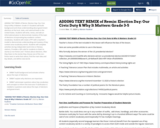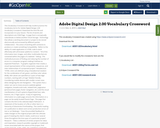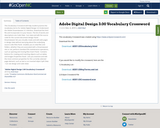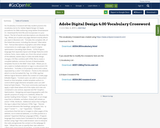
This parent guide supports parents in helping their child at home with the 8th grade Social Studies content.
- Subject:
- Social Studies
- Material Type:
- Reference Material
- Vocabulary
- Author:
- Kelly Rawlston
- Letoria Lewis
- Date Added:
- 10/12/2022

This parent guide supports parents in helping their child at home with the 8th grade Social Studies content.

ADDING TEXT REMIX of Remix: Election Day: Our Civic Duty & Why It Matters: Grade 3-5
Students will build background and show understanding about government elections at the local, state, and national levels in the United States.
Students will write, revise, and edit an informational piece to demonstrate mastery of the topic of elections incorporating key academic content vocabulary.
Students will create a PPT with a teacher's model to demonstrate understanding and mastery of key content area vocabulary words.
Students will complete activities during independent work time or literacy stations. Provides a QR code for students to listen to stories (2 non-fiction and 1 fiction) about elections. After they listen to the stories they choose one of the non-fiction texts to write facts about, find the main idea and key details, and define new words

This Vocabulary Crossword will help student practice the vocabulary terms for Adobe Digital Design 1.0 Understand Project requirements for Web Development.
Download the html file and incorporate it in your lesson. The list of words and descriptions are
CREATIVE COMMONS: Free, easy-to-use copyright licenses provide a simple, standardized way to give the public permission to share and use your creative work on conditions of your choice
FEEDBACK: Verbal or written responses containing information about a client’s reaction to a designer’s performance of a task
SCREEN READER: Recites text that appears on the computer screen, as well as, non-textual information, such as button labels or image descriptions, provided during designing
ACCESSIBILITY: Making websites functional for people with visual, auditory, motor, and other disabilities
FAIR USE: A legal allowance of using a copyrighted material without permission from the owner, provided the circumstances are reasonable and do not make the material less profitable
TRADEMARK: A mark (logo, symbol, word, phrase, etc.) legally registered or established by a company to represent a service or product; cannot be used without the permission of the owner
DELIVERABLES: Completed products requested by client (design, website, app, video, etc.)
PROJECT MANAGEMENT: The application of processes, methods, knowledge, skills and experience to achieve the project objectives
PROJECT PLAN: Helps move a project successfully to completion, includes deciding project scope, client criteria, project deliverables, and distribution of responsibilities
COPYRIGHT: The exclusive legal right to reproduce, publish, sell or distribute the expression of an intellectual property (literature, design, audio, video, etc.)
INTELLECTUAL PROPERTY: Original creations of the mind that can be protected by law; literary and artistic works, designs, symbols, images, names, etc.
SCHEDULE: Setting deadlines for each project phase and task
SCOPE CREEP: Incremental expansion of the project scope, introducing features not originally planned
PROJECT SCOPE: Identifying audience, goals, and objectives

This Vocabulary Crossword will help student practice the vocabulary terms for Adobe Digital Design 2.00 Vocabulary Crossword. Download the html file and incorporate it in your lesson.
The list of words and descriptions are
Child Page : A page that is conceptually subordinate or below another
Cloud Storage : Technology that allows a working document or project to be stored electronically and accessed by different parties
Collaboration : The action of working with someone to produce or create something
Compatibility : Refers to the ability of a web application or HTML code to work effectively with all browser platforms
Content : "All of the information text, images, and other multimedia that are contained within the pages of a website "
Debug : The methodical process of finding and reducing the number of errors in a computer program making it behave as expected
Flowchart : "A graphic organizer that creates a visual representation of the components, sequences, and inter-relationships of a proposed project"
Hexadecimal : "HTML colors are defined using a hexadecimal notation for the combination of red, green, and blue color values (RGB), HEX values are specified as 3 pairs of two-digit numbers, starting with a # sign"
Mobile Friendly : Considering mobile devices with smaller screen sizes when designing the site
Navigation : "The system that a visitor can use to move around a website (global navigation, breadcrumb trails, related links, pagination (previous/next page), footer navigation, etc.) and the visual manifestation of such systems (hyperlinked text, tabs, buttons, etc.)"
Page Layout : A way of organizing information on a web page; ensures the information on a page can be easily located
Parent Page : The page that contains the link to the selected object
Pathname : A statement of the location of a file or other item in a hierarchy of directories
Proofreading : The careful reading of a publication to detect and correct production errors of text or art
Redesign : "Uses the provided feedback to make changes to the original project with the ultimate goal of meeting the client’s needs, could occur several times throughout the time span of a particular project"
Research : "View a collection of similar projects for ideas and inspiration, research possible copyright or trademark issues associated with the nature of the project, find assets (pictures, audio, video, etc.) needed to create the project"
Root Folder : The folder that holds all of the files that make up your actual website
Source Code : Program or web page instructions in their original form
Text Editor : Simple text editing program used to write or edit web design code; does not show a visual component
Usability : "Good web usability involves effectiveness, efficiency and satisfaction of the website being used"
Visual Editor : Design software that manipulates components of the web page without the user writing or editing code
Web-safe Colors : "Consist of 216 colors that display solid, non-dithered, and consistent on any computer monitor, or web browser, capable of displaying at least 8-bit color (256 colors)"
Website Hosting : The activity or business of providing storage space and access for websites
Wireframe : A visual guide to how a web page content will be organized; assists in the arrangement and scaling of design components
WYSIWYG : What You See Is What You Get

This Vocabulary Crossword will help student practice the vocabulary terms for Adobe Digital Design 3.0 Understand the Adobe Dreamweaver CC interface.
Download the html file and incorporate it in your lesson. The list of words and descriptions are
Code View : Can view and edit the source code for the current document
Design Panel : Dreamweaver lets you visually create and edit web pages in design view without worrying about the underlying source code
Files Panel : Enables you to view files and folders, whether they are associated with a Dreamweaver site or not, perform standard file maintenance operations, such as opening and moving files
Insert Panel : Contains buttons for creating and inserting objects such as tables and images
Properties Panel : Lets you examine and edit the most common properties for the currently selected page element, such as text or an inserted object
Split View : Can see design and code views

his Vocabulary Crossword will help student practice the vocabulary terms for Adobe Digital Design 4.0 Apply procedures for Web authoring using Adobe Dreamweaver CC.
Download the html file and incorporate it in your lesson. The list of words and descriptions are
Absolute Div Tag : Allows you to place any page element exactly where you want it
Absolute Link : "Includes the complete URL of the linked document, including the domain"
Alternative Text : Textual descriptions of graphics and other design components on a web page; aids in search engine optimization
Cascading Style Sheets : "(CSS) Program language that separates layout and design features (color scheme, fonts, menu styles, etc.) from the actual content of the website; easiest way to make site-wide design changes; CSS files combine with HTML file to create a complete website; common format of downloadable templates found on the Web"
Class Style : Allows you to set a style to multiple element or tags in a document
CSS Declaration : "Includes a CSS property name and a value, separated by a colon"
CSS Selector : Points to the element which is to be formatted
Div Tag : An HTML tag that defines logical divisions within the content of a web page
Editable Region : "Content users can edit in a document based on that template, enable template authors to control which page elements template users can edit"
External Style Sheets : "The most commonly used way to apply a style sheet where all of the styles and rules are contained in one central, separate text file"
Graphics Optimization : Designing and exporting graphics with the specific purpose of using it on a website; allows for quicker loading times
Hotspot : "Any region on an image map that is clickable, and when clicked, will initiate an action"
HTML Attribute : Additional values that configure the tag or adjust their behavior
HTML Tags : "Denote structured elements like headings, paragraphs, lists:
...
"